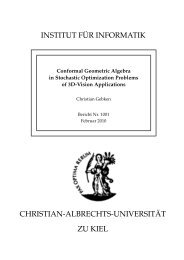Curry: An Integrated Functional Logic Language
Curry: An Integrated Functional Logic Language
Curry: An Integrated Functional Logic Language
You also want an ePaper? Increase the reach of your titles
YUMPU automatically turns print PDFs into web optimized ePapers that Google loves.
Eval [try(g)] ⇒<br />
⎧<br />
[] if Eval [c] ⇒ ∅<br />
⎪⎨<br />
⎪⎩<br />
[g ′ ] if Eval [c] ⇒ {σ success} (i.e., σ is a mgu for all equations in c) with<br />
Dom(σ) ⊆ {x, x1, . . . , xn} (or c = success and σ = id) and<br />
g ′ = \x->let x1, . . . , xn free in σ ◦ ϕ success<br />
D if Eval [c] ⇒ {σ c ′ } with Dom(σ) ⊆ {x, x1, . . . , xn},<br />
g ′ = \x->let x1, . . . , xn, y1, . . . , ym free in σ ◦ ϕ c ′<br />
where {y1, . . . , ym} = VRan(σ) \ ({x, x1, . . . , xn} ∪ free(g)),<br />
and Eval [try(g ′ )] ⇒ D<br />
[g1,...,gk] if Eval [c] ⇒ {σ1 c1, . . . , σk ck}, k > 1, and, for i = 1, . . . , k,<br />
Dom(σi) ⊆ {x, x1, . . . , xn} and<br />
gi = \x->let x1, . . . , xn, y1, . . . , ymi free in σi ◦ ϕ ci<br />
where {y1, . . . , ymi } = VRan(σi) \ ({x, x1, . . . , xn} ∪ free(g))<br />
Figure 5: Operational semantics of the try operator for g = \x->let x1, . . . , xn free in ϕ c<br />
It is easy to see that this algorithm computes a definitional tree for each function since the<br />
number of rules is reduced in each recursive call and it keeps the invariant that the left-hand sides<br />
of the current set of rules are always instances of the current call pattern.<br />
Note that the algorithm gt is not strictly conform with the pattern matching strategy of functional<br />
languages like Haskell or Miranda, since it generates for the rules<br />
f 0 0 = 0<br />
f x 1 = 0<br />
the definitional tree<br />
branch(f(x1,x2), 2, flex, branch(f(x1,0), 1, flex, rule(f(0,0) = 0)),<br />
rule(f(x1,1) = 0))<br />
(although both arguments are demanded, only the second argument is at an inductive position)<br />
whereas Haskell or Miranda have a strict left-to-right pattern matching strategy which could be<br />
expressed by the definitionl tree<br />
or(branch(f(x1,x2), 1, flex, branch(f(0,x2), 2, flex, rule(f(0,0) = 0))),<br />
branch(f(x1,x2), 2, flex, rule(f(x1,1) = 0)))<br />
The latter tree is not optimal since it has a non-deterministic or node and always requires the<br />
evaluation of the first argument (in the first alternative). If the function definitions are uniform in<br />
the sense of [48], the strategy described by gt is identical to traditional functional languages.<br />
D.7 Encapsulated Search<br />
The exact behavior of the try operator is specified in Figure 5. Note that a substitution ϕ of the<br />
form {x1 ↦→ t1, . . . , xn ↦→ tn}, computed by evaluating the body of a search goal, must be encoded as<br />
a constraint in the new search goal. Therefore, ϕ is transformed into its equational representation<br />
ϕ, where ϕ is a solved constraint of the form x1=:=t1 &...& xn=:=tn. Hence, a search goal can<br />
72
















